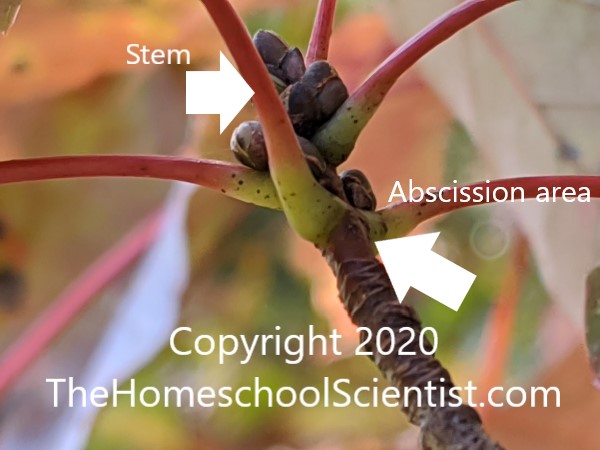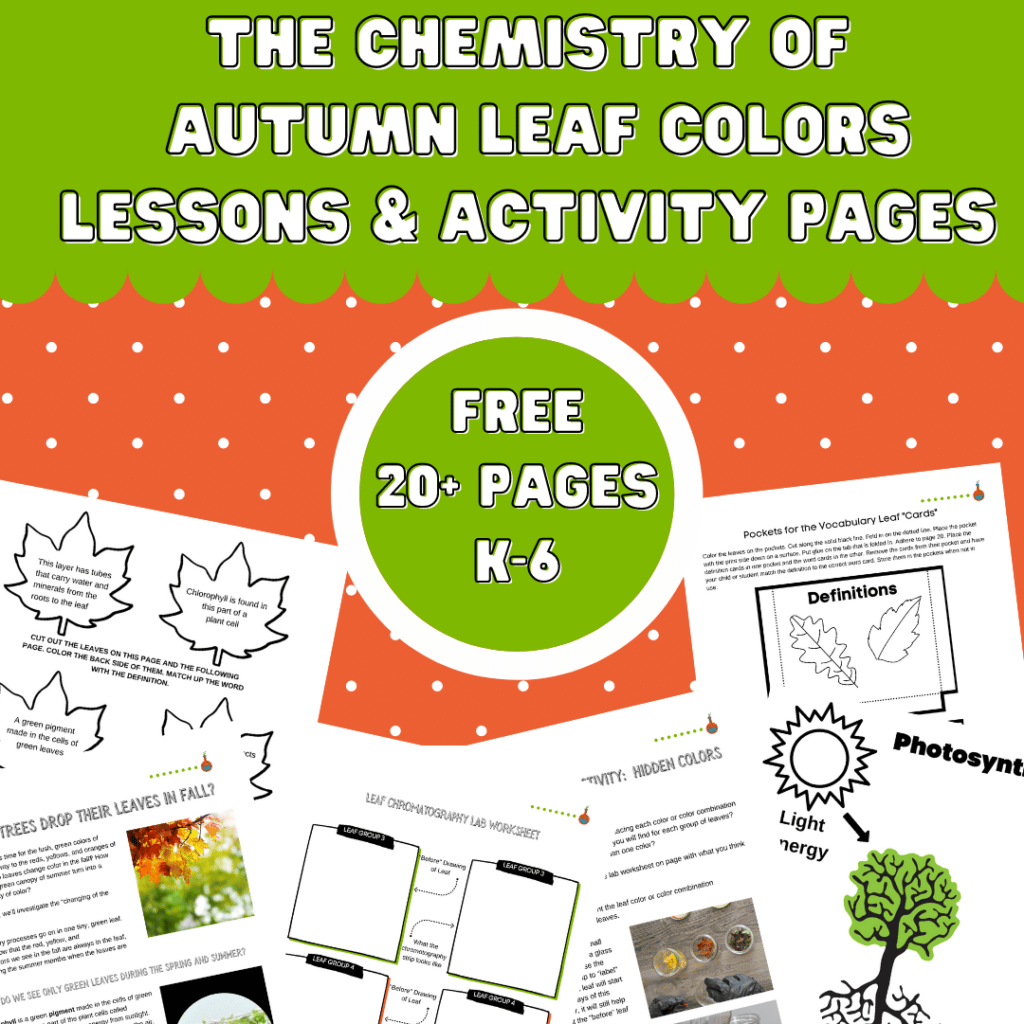Why Do Leaves Change Color in Fall?
Fall is the time for the lush, green colors of summer to give way to the reds, yellows, and oranges of autumn. Why do leaves change color in the fall? How does the cool, green canopy of summer turn into a stunning display of color?
This post contains affiliate links. Thank you for supporting our work at TheHomeschoolScientist.com.
Why Do Leaves Change Color in Fall?
In this lesson, we’ll explain the “changing of the colors.”
Don’t forget to download the FREE 20+ page printable lesson at the bottom of this post that goes along with this post so your homeschool, class, or co-op can enjoy the investigation into why leaves change color in fall.
Extraordinary processes go on in one tiny, green leaf. Did you know that the red, yellow, and orange colors we see in the fall are always in the leaf, even during the summer months when the leaves are green?
Why do we see only green leaves during the spring and summer?
Plants need water, carbon dioxide, and sunlight to produce their food called glucose. Plants obtain water from the air and the ground via their roots. Carbon dioxide is obtained from the air.
Chlorophyll is a substance made in the leaves that captures light energy from the Sun and uses it to break down the water and carbon dioxide into the plant’s food called glucose. This food-making process is called photosynthesis.
The chlorophyll breaks down with exposure to sunlight, so the leaf must always make new chlorophyll.
The chlorophyll breaks down with exposure to sunlight, so the leaf must always make new chlorophyll. As the Sun becomes less intense in fall, chlorophyll production slows down. This is why leaves change color in the fall.
Plants need water, carbon dioxide, and sunlight to produce their food called glucose. Plants obtain water from the air and the ground via their roots. Carbon dioxide is obtained from the air.
The Abscission Area of Leaves
Look closely at the photo of the leaves below. Notice the base of the leaf where it connects to the tree branch. There is a layer of cells at the base of the leaf called the abscission layer. In this layer are tubes that carry water and minerals from the roots to the leaf. During the spring and summer, these tubes are open, allowing the leaf to obtain all its nutrients, produce chlorophyll, and produce large amounts of food—glucose. Extra glucose is made and stored as starch and saved for the shorter days that come in fall.
What are these different colors?
These colors are various pigments in the leaf. Pigments are substances that provide color and are also used to give the paint its coloring. The orange color comes from carotene (just like carrots!); the yellow from xanthophylls, the purple from anthocyanin, and brown is from tannin. Mixes of these colors produce the beautiful colors we enjoy each autumn.
Now that we know why leaves change color in the fall, let’s talk about why trees lose their leaves.
Why don’t these beautifully colored leaves stay on all fall and winter?
- Why can’t we enjoy the spectacular show of colors all winter? Like chlorophyll, these colorful pigments begin to break down as they are exposed to sunlight and freezing temperatures. The only pigment that doesn’t break down is tannin, which gives the leaves that stay on the tree their brown color.
- Most leaves will eventually fall off the tree branches. (Some even fall off while they are still beautifully colored.) Remember the abscission layer? (It is at the base of the leaf where the leaf attaches to the tree branch.) The connections between the cells in this layer eventually weaken, and the leaf falls away from the branch.
Some fall seasons bring bright colors in the leaves and other seasons are not as colorful. Why does this happen?
Several things can affect the quality of the autumn leaf colors: temperature, moisture, and sunlight.
- Cool night temperatures and lots of sunlight produce more anthocyanin (the purple pigment).
- Early frost hurts the process that produces anthocyanin. An early frost brings an end to the bright colors.
- A drought during the spring and summer months might cause the abscission layer to thicken up early, and the leaves fall off before they have time to change completely.
- The red colors caused by the anthocyanins are enhanced by cold and sunny weather during fall. If Fall weather is warmer or brings more rain, the anthocyanin display could be shortened.
Fall Leaves Science Activity: Hidden Colors
It’s time to do some hands-on investigating to see where the beautiful colors are as we see the leaves change color in the fall.
The following activity is an easy way to show your child how colors can be hiding within other colors—just like the reds, yellows, and oranges of a leaf are “hidden” by the green color of chlorophyll.
The method we will be using to separate the colors is called paper chromatography. Chroma means “color” in Greek and graphein means “to write” in Greek. Chromatography is the separation of a substance into its component parts. In this experiment, we will see all of the colors or pigments in the leaves. Do you think a leaf that is red will only show red pigment?
Let’s find out!
Note to Teacher or Supervising Adult:
- Parents should handle the acetone and use outdoors until the jar lids are securely tightened.
- Gloves and safety goggles or a face shield should be used when handling the 100% acetone.
- You may use fingernail polish remover that is 100% acetone.
What you’ll need for this experiment:
- The FREE 20-page activity packet that goes along with this post. See the sign-up box at the end of this post.

- 5 leaves (each) of varying colors and color combinations. You will need to gather leaves of various colors. Pick up 5 leaves of each color. You will use one of the leaves as a “label” for your experiment jars. (If it’s spring or summer, gather leaves that are varying shades of green to see what happens.)
- Coffee filters cut into 1”-wide strips (that will reach from the bottom of the glass jars or test tubes over the edge of the container)
- Fingernail polish remover (100% acetone). You will need 2 to 3 ounces for each leaf sample you gathered. You can also use 100% acetone found in the paint section of home improvement stores.
- Jars with lids or test tubes in a test tube holder
- A spoon or utensil that will fit into the jars or test tubes
- Tape (optional)
What to Do:
Place the leaves you gathered on a table, placing each color or color combination in a pile together. What colors do you think you will find for each group of leaves? Do you have any leaves that have more than one color?
Fill out the Hypothesis section of the lab worksheet (download the lesson worksheets) with what you think is going to happen.
Next, draw a picture to represent the leaf color or color combination represented by each grouping of leaves.
Tear 4 of the leaves into small pieces and put the pieces in a glass jar (with lid) or test tube. Use the remaining leaf in the group to “label” the jar or test tube. This leaf will start to dry out over the 2 days of this experiment. However, it will still help you remember what the “before” leaf looked like.
Add enough acetone to the jar or test tube to cover the leaves. We used about 2 to 3 ounces, depending on the amount of leaf material.
Mash the leaves gently with the spoon for about 45 seconds. If using test tubes, you may need to use a straw to mash the leaves.
Cover each container tightly and let the leaves sit in a safe location for 24 hours. Please keep out of reach of small children.
While waiting for the 24 hours to complete, cut the coffee filter into 1” strips so the strip will sit inside the liquid and drape over the side of the jar or test tube.
After the 24 hours have passed, place a coffee filter strip into each jar, so it is in the acetone/pigment mixture and then resting over the edge of the container. Place the lid back on the jar or test tube. We very loosely tightened ours and put out of the way of little hands and in a well-ventilated area
Let sit another 24 hours. Then remove the strip from the acetone and observe.
What do you see? Ask your child to describe what happened. Download the free lesson below and have your student complete the fun lab activities!
What Happened In The Leaf Chromatography Experiment
This experiment uses a method called chromatography The acetone dissolved the pigments in the leaf pieces. A leaf may appear only to be one or two colors until the pigment molecules go through the paper chromatography process. The coffee filter absorbs the pigment molecules. The larger molecules get trapped first, and the smaller molecules travel a little further along the paper, which is why you might see stripes of pigment when there is more than one pigment present.
Check out some websites of interest:
- Bookmark The Farmer’s Almanac fall foliage page and check it each year for your area of the U.S.
- How about a few fun lessons on soil? The USDA has lesson plans for all grades levels.
- The U.S. Forest Service has a wide variety of activities for kids. Plus, check out the link on the sidebar for educators.
Download the 20-page activity pack to add this study of why leaves change color in Fall to your homeschool, co-op, or classroom. Includes informational write-ups, science activities, activity pages, and more! Use the email request box below.
We’ve Learned Why Leaves Change Color in the Fall – What Next?
Enjoy all of the activity pages in the FREE download below and hit the share button to let your friends know about this free learning resource. You will be added to our e-newsletter community. We do not like spam and will not share email addresses with third parties or sell our email list. We just want to share quality resources with you, like this free unit.
I hold a master’s degree in child development and early education and am working on a post-baccalaureate in biology. I spent 15 years working for a biotechnology company developing IT systems in DNA testing laboratories across the US. I taught K4 in a private school, homeschooled my children, and have taught on the mission field in southern Asia. For 4 years, I served on our state’s FIRST Lego League tournament Board and served as the Judging Director. I own thehomeschoolscientist and also write a regular science column for Homeschooling Today Magazine. You’ll also find my writings on the CTCMath blog. Through this site, I have authored over 50 math and science resources.












